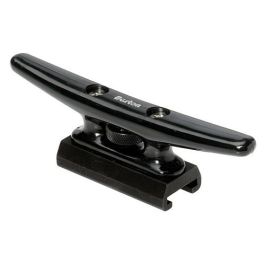Our Hunter 34 has stern and bow cleats but no cleat at midships. As a result, we normally fix two lines to each cleat at the dock: A bow or stern line plus a spring line. The challenge is our cleats aren't very large and don't have a centre hole to thread through for a stronger hold so the two lines just barely fit together over the cleats.
A guy was telling me about a different sort of tie that only uses two (very long) lines. Using the bow line as an example, it starts fixed to the toe rail or stanchion amidships, down to the dock then up to the bow cleat and finally back to the dock immediately below. Same thing for the stern. In this way each line fills a dual function of bow/stern line and spring line. Has anyone tried this or have an opinion on it? My first thought is it would be more difficult to adjust so the boat is sitting just right at the dock. (We like to pull our stern in for easier boarding.)
Adding to this, he suggested that the lines be tied off at the toe rail amidships and coiled/stored hanging on the lifeline when not in use. In this way, when single handing I can grab one of the lines and loop it at the dock amidships first, which will balance the boat at the dock. Then run it back to he stern or bow cleat, and back to the dock. I suppose you'd need a set of lines hanging on both port and starboard lines to allow for tying on either side. As I write this it all sounds impractical but thought I'd see if anyone else has tried.
A guy was telling me about a different sort of tie that only uses two (very long) lines. Using the bow line as an example, it starts fixed to the toe rail or stanchion amidships, down to the dock then up to the bow cleat and finally back to the dock immediately below. Same thing for the stern. In this way each line fills a dual function of bow/stern line and spring line. Has anyone tried this or have an opinion on it? My first thought is it would be more difficult to adjust so the boat is sitting just right at the dock. (We like to pull our stern in for easier boarding.)
Adding to this, he suggested that the lines be tied off at the toe rail amidships and coiled/stored hanging on the lifeline when not in use. In this way, when single handing I can grab one of the lines and loop it at the dock amidships first, which will balance the boat at the dock. Then run it back to he stern or bow cleat, and back to the dock. I suppose you'd need a set of lines hanging on both port and starboard lines to allow for tying on either side. As I write this it all sounds impractical but thought I'd see if anyone else has tried.
Attachments
-
393.1 KB Views: 269
Last edited:







